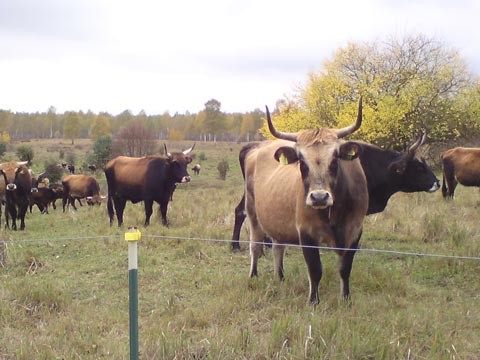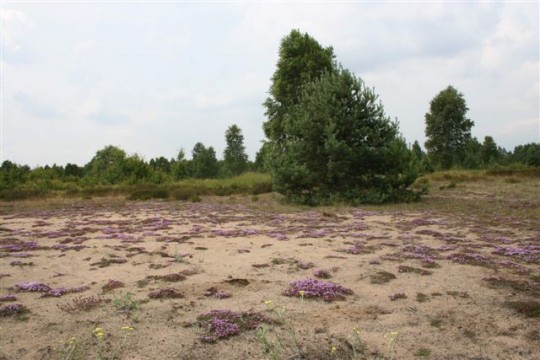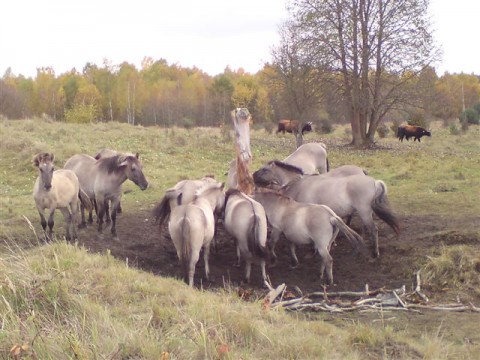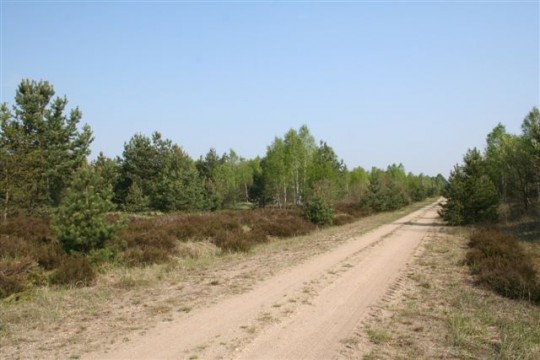



Oranienbaum Heath
The Natura 2000 area “Middle Oranienbaum Heath” is 2,000 hectares and located between the cities of Oranienbaum and Dessau in the catchment area of the lower Mulde. Oranienbaum Heath is divided into two geological regions. The south is dominated by tracts of moraine, extensions of the Gräfenhainichen-Söllichau Plate, which is a ground moraine with remains of a terminal moraine produced from the Dübener push moraine during the Drenthe stage of the Saale glacial. The northern part is located within the Magdeburg glacial valley where low terraces, formed by the Elbe and Mulde, resulted in the creation of the Oranienbaum valley sand region.
The Natura 2000 area is characterized by the following types of habitats that, according to Annex I of the Fauna-Flora Habitat Directive, are of particular common interest in Europe:
- Dry sandy heath with Scotch heather and broom (on inland dunes) (LRT 2310)
- Dunes with open grasslands with whitish hair-grass and bent grass (LRT 2330)
- Dry European heaths (LRT 4030))
- Dry, calcareous sandy grasslands (LRT 6120*)
- Rivers of the lowland-montane level with water crowfoot vegetation (LRT 3260)
- Wet meadows with herbaceous perennials of the lowland-montane-alpine level (LRT 6430)
Oranienbaum Heath is a landscape that has been subject to a steady fluctuation in its ratio of forest to open habitats. Up until the 19th century its forests were intensively used for fuel, building materials, litter extraction and hunting. Names such as "Oranienbaumer Hutung“ [Oranienbaum Pastures], southwest of the city of Oranienbaum are testament to its use as a place for herding - primarily pigs, sheep and goats. In the late 19th century and the first decade of the 20th century, red deer and fallow deer were kept in enclosures here. With the introduction of Prussian forestry practices in the 18th century, the area was turned into extensive pine forests until the beginning of the 20th century.
An extensive transformation of the landscape occurred with the establishment of the “Möhlau-Sollnitz” military training grounds in 1945. By 1956 only small clearings had been made, however this was followed by large-scale deforestation until 1964. One thousand hectares were cleared through fire and deforestation and used, along with the adjacent forest areas, as a firing range for small arms, low calibre artillery and tanks. The military training ground was expanded to include 2,500 hectares by 1966 and shooting ranges, petrol depots and shooting houses were erected. By the end of the 1970s the training grounds had been expanded to 4,067 hectares mainly due to regular fires in the outlying areas (e.g. in the field camps). By 1991/92 the former Soviet army had completely withdrawn from the area and left behind a large, anthropogenically marked region of open habitats. These open habitats were almost devoid of trees and had many patches of bare soil and large-scale sandy heath biotopes. After military operations ceased in 1992, the risks connected to this type of usage became apparent: the ground was contaminated with munitions, paths and sections of forest were dangerous to use and the upper layers of soil were contaminated through compaction, oil/fuel and scrap metal. Continued use of the area, e.g. for forestry purposes, was prohibited in accordance with Saxony-Anhalt’s Explosive Ordnance Danger Aversion Regulations.
Nevertheless, because of the geological conditions and the different intensities of previous use, a mosaic of Natura 2000 habitats could be preserved and developed on around 1,000 hectares located in the centre of Oranienbaum Heath. These habitats are combined with grasslands, herbs, small wetlands, bushes, copses and pioneer forests. The area is considered nationally to be an excellent refuge for endangered habitats and communities of plants and animals. It is also one of the areas in Saxony-Anhalt that has the most diverse number of biotopes and species. A list of endangered or extremely endangered species, established over the past few years for Oranienbaum Heath, can be found at the end of this article.
A biotope and habitat mapping of the 2007 vegetation period (Anhalt UAS, 2007) showed that in the 15 years since military usage ceased, vegetation encroachment - in the form of pioneer trees like sand-birch, forest pine and trembling poplar and, in places, neophytic late-blooming bird cherry trees - is relatively well-advanced over a large percentage of the heath. At the same time, there were already large stocks of Scotch heather of an advanced age, i.e. vegetative regeneration was rarely observed, and seedlings and young plants were completely lacking. The abandonment tendencies of perennial, highly competitive species in the alkaline-rich sandy grasslands and an increasing overgrowth of whitish hair-grass pioneer meadows on the inland dunes were proving to be particularly problematic. As a result, the state of preservation in many areas could only be classified as medium or poor.
In order to develop and ensure a good state of preservation and to safeguard the habitats of animal and plant species, which according to Annex II and IV of the Natura 2000 Directive are also of common interest and endangered throughout Europe, extensive, all-year-round grazing areas, populated with Heck cattle and Konik horses, were established as part of the model project “Management of Natura 2000 habitats in the Oranienbaumer Heide” funded by the German Federal Foundation for the Environment (DBU). The project, which ran from May 2008 to April 2011, was coordinated and scientifically supported by the Department of Agriculture, Nutritional Sciences and Landscape Development at Anhalt University of Applied Sciences. Project partners were Middle Elbe Biosphere Reserve, Primigenius – Köthener Naturschutz und Landschaftspflege gGmbH and Förder- und Landschaftspflegeverein "Mittelelbe“ e.V. Cooperation partners included the Federal Office for Real Estate Issues, Federal Forestry Office “Middle Elbe” and David Nature Foundation. Furthermore the project was funded by Saxony-Anhalt’s Environment, Nature Conservation and Climate Protection Foundation and through the European Agricultural Fund for Rural Development.
The 300 hectares of grazing land established in 2008 were expanded to 800 hectares by 2011. Focus was on conserving a semi-open grazing area in accordance with nature conservation standards and not a profit-oriented farming of pastureland animals. By populating the land with cattle and horses, the species-specific impact in terms of feeding behaviour and tread and wallowing activities were used to keep the habitats open. In accordance with site conditions, a stocking of around 0.15 livestock units per hectare was planned which was equivalent to around one cow or one horse per 6-7 hectares. Currently there are around 40 Heck cattle and 14 Konik horses on the pastureland.
As a consequence of poor land management since the 1990s, the removal of shrubs in selected open habitats was carried out. Wood structures in the form of single trees or bushes were always left in the area. Beyond the pasture, species-rich herbaceous perennial meadows surrounding the Mochwiese meadows were mowed at the millstream between Möhlau and Sollnitz.
The initial scientific results for the extensive pasturing revealed that there were positive developments throughout the entire area after 1.5 years. This included a clear reduction in litter material and an increase in the structural diversity in the herb layer. The highly competitive reed grass was suppressed and reduced in all habitats. Because cattle were able to intensively suppress the shoots of the late-blooming bird cherry, further spread of the neophytic and invasive species could be prevented. There were already spots of vegetative regeneration of the heather which were distributed throughout the entire area. Nevertheless an improvement in the state of conservation of the heather will take much longer than for habitats dominated by grasses. The collection of data on avifauna, diurnal butterflies/moths and grasshoppers in 2009 is impressive proof of the value of preserving open habitats on Oranienbaum Heath.
Based on the way forward agreed upon by all regional players, research was carried out into possibilities for clearing explosive ordnance on the hiking trails. This would allow residents to walk through and experience the area over the medium term and to establish environmental education activities without this having a negative impact on the current ecological space.
| Plant species creating nature conservation value for the Natura 2000 habitats of Oranienbaum Heath: | Directive Saxony-Anhalt |
| Echte Mondraute | 3 |
| Daisy-leaved moonwort | R |
| Winged broom | 1 |
| Mountain parsley | 3 |
| Rock cinquefoil | 1 |
| Prairie Junegrass |
|
| Rare spring sedge | 3 |
| Species of spinders: |
|
| Oxyopes ramosus | 2 |
| Philodromus histrio | 3 |
| Neriene furtiva | 1 |
| Eresus cinnaberinus Ladybird spider | 3 |
| Micaria dives | 2 |
| Insect species: |
|
| Lesser mottled grasshopper | 2 |
| Large marsh grasshopper | 3 |
| Wart biter | 2 |
| Large grizzled skipper | 1 |
| Berger’s clouded yellow | 3 |
| Brown argus |
|
| Scotch argus | 3 |
| Rock grayling | 1 |
| Grayling | 3 |
| Transparent burnet | 3 |
| Beautiful demoiselle | 2 |
| Amphibians and reptiles: |
|
| Moor frog | 3 |
| Common spadefoot |
|
| European green toad | 3 |
| Sand lizard | 3 |
| Smooth snake | G |
| Birds: Wryneck, red-backed shrike, great grey shrike, woodlark, corn bunting |
|
| Quail |
|
| Nightjar | 2 |
| Barred warbler |
|
| Whinchat | 3 |
| Common stonechat |
|
| Tawny pipit | 2 |
| Hoopoe | 1 |
| Hobby |
|
| Crane |
|
| Mammals: |
|
| Water shrew | 3 |
| Lesser white-toothed shrew | R |
| Pygmy shrew | 3 |
| Hare | 2 |
| diverse bat species |
|